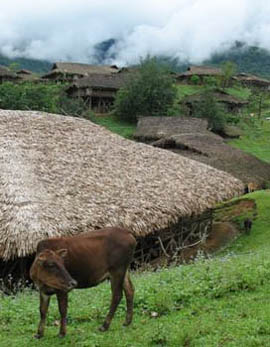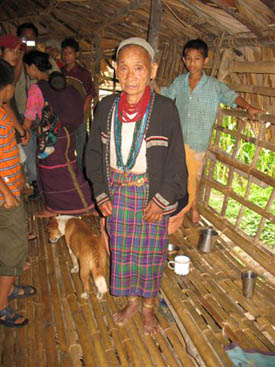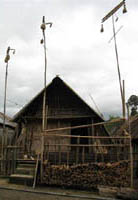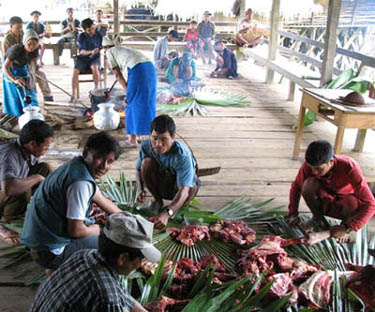|
Into the Unknown
Arunachal Pradesh, North East India
by Sarah Shuckburgh
Sarah Shuckburgh witnesses ritual sacrifice in a remote
province of north east India, only recently opened to
visitors.
India’s most remote and least populated province,
Arunachal Pradesh, is one of the last wildernesses in the
world. Few travellers have seen this spectacular Himalayan
landscape of subtropical forest and lush jungle, where dozens of tribal
groups carry on traditions unchanged for centuries. Largely
unexplored and unmapped during the Raj, the region has been
closed to outsiders since 1962, when the Chinese invaded and
were repelled. Tourism is now allowed, although the border
is still sensitive and visitors need special permits. I am
told that I am the first foreign journalist to visit the
area.
subtropical forest and lush jungle, where dozens of tribal
groups carry on traditions unchanged for centuries. Largely
unexplored and unmapped during the Raj, the region has been
closed to outsiders since 1962, when the Chinese invaded and
were repelled. Tourism is now allowed, although the border
is still sensitive and visitors need special permits. I am
told that I am the first foreign journalist to visit the
area.
My husband Guillaume, an entomologist, had always dreamed of
following in the footsteps of Stanley Kemp, a zoologist who
accompanied an army exhibition to Arunachal Pradesh in 1911
and found beetles that have never been seen since. Although
I’d never heard of Arunachal or Kemp, I was keen to witness
traditional customs unlikely to survive once India’s tribal
education policies reach remote villages.
Leaving the Brahmaputra valley, we drove north into the
densely forested Himalayan foothills, zigzagging round
vertiginous gorges of palms and tree-ferns, on a road newly
built so that troops can move quickly in the event of
another invasion. We passed gangs of itinerant road-workers,
hacking stones from hillsides and heating tar above blazing
fires, while their ragged children loitered outside shacks
made out of oil drums and thatch. There was almost no
traffic, but roadside signs proclaimed the Border Roads
Organisation’s rhyming homilies: “Don’t race, drive with
grace”, “Speed is a knife that cuts a life”. Whenever the
road dipped to cross a mountain stream, we stopped the car
and Guillaume searched for beetles in mossy waterfalls,
while I walked on ahead, beneath strange flowering trees
with clusters of bright yellow blooms and dangling white
bracts, and between verges of wild cannabis.
 As we reached the land of the Nishi, the road was often
blocked by apricot-coloured mithuns, a species of humped
cattle native to the eastern Himalayas, and highly prized as
evidence of wealth, for buying brides and for ritual
sacrifice. The Nishi live in communal longhouses, built on
wigwam-like stilts, with walls of woven banana palm and
shaggily thatched roofs. Pigs,
chickens and goats scavenge beneath the houses. Guillaume
disappeared into the undergrowth with his sieve, and I
strolled through the village with Doljit, our Assamese
guide. Women in bead necklaces and tartan sarongs stared at
me, open-mouthed, as Doljit chatted to them in their
dialect. His Mongolian features conveniently allowed him to
pass for a member of some nearby tribe, and within minutes
we were invited into a longhouse. Coils of rope tied to the
door frame showed that this household owned many mithuns. We
clambered up a notched log and ducked under a lintel into a
low, dark room. The flimsy floor creaked and bounced with
each step and I was afraid of falling through the
widely-spaced bamboos, but
gradually, through the smoky gloom, I noticed babies
fearlessly toddling over the gaps. As we reached the land of the Nishi, the road was often
blocked by apricot-coloured mithuns, a species of humped
cattle native to the eastern Himalayas, and highly prized as
evidence of wealth, for buying brides and for ritual
sacrifice. The Nishi live in communal longhouses, built on
wigwam-like stilts, with walls of woven banana palm and
shaggily thatched roofs. Pigs,
chickens and goats scavenge beneath the houses. Guillaume
disappeared into the undergrowth with his sieve, and I
strolled through the village with Doljit, our Assamese
guide. Women in bead necklaces and tartan sarongs stared at
me, open-mouthed, as Doljit chatted to them in their
dialect. His Mongolian features conveniently allowed him to
pass for a member of some nearby tribe, and within minutes
we were invited into a longhouse. Coils of rope tied to the
door frame showed that this household owned many mithuns. We
clambered up a notched log and ducked under a lintel into a
low, dark room. The flimsy floor creaked and bounced with
each step and I was afraid of falling through the
widely-spaced bamboos, but
gradually, through the smoky gloom, I noticed babies
fearlessly toddling over the gaps.
 We crouched round a smouldering hearth in the middle of the
room, while a shy woman with cropped hair poured steaming
liquid from a blackened kettle. Soon we were sipping hot,
salty tea from small tin cups. Above us, joints of meat hung
in the smoke, and firewood and rice dried on plaited trays.
The palm-frond walls were bare apart from two faded photos,
a jagged piece of mirror, and a bow and quiver of arrows.
Sarongs and bedding dangled from a bamboo rail, beside a
five-foot stack of mithun skulls. A wizened man appeared in
the doorway, sporting a rattan helmet trimmed with an eagle
claw, bearskin, hornbill beak and drongo feathers. He
carried a conical basket of woven rattan on his back, and a
fur-trimmed machete at his hip. Skinny, wrinkled legs poked
from his pleated loincloth. He nodded at us with shy
curiosity as he sat on his haunches and lit a bamboo pipe. We crouched round a smouldering hearth in the middle of the
room, while a shy woman with cropped hair poured steaming
liquid from a blackened kettle. Soon we were sipping hot,
salty tea from small tin cups. Above us, joints of meat hung
in the smoke, and firewood and rice dried on plaited trays.
The palm-frond walls were bare apart from two faded photos,
a jagged piece of mirror, and a bow and quiver of arrows.
Sarongs and bedding dangled from a bamboo rail, beside a
five-foot stack of mithun skulls. A wizened man appeared in
the doorway, sporting a rattan helmet trimmed with an eagle
claw, bearskin, hornbill beak and drongo feathers. He
carried a conical basket of woven rattan on his back, and a
fur-trimmed machete at his hip. Skinny, wrinkled legs poked
from his pleated loincloth. He nodded at us with shy
curiosity as he sat on his haunches and lit a bamboo pipe.

As we drove away, we saw men hacking steep slopes to make
rice terraces, and women in sarongs, bent double to plant
bright green seedlings in flooded beds. Several youngsters
wore jeans and tee-shirts, with hair gelled and dyed auburn.
Younger children scampered along the narrow dykes and stared
at our car in astonishment,
but none asked for pens or sweets. As part of his
anthropology degree, Doljit studied the ethics of tribal
tourism, and he urged us not to offer villagers presents or Polaroids.

Crossing the river boundary into the land of the Apatani, we
drove through dense bamboo plantations and over glittering
paddy fields where boys were fishing with rods and carrying
their catch home in rounded (not conical) rattan backpacks.
We stopped at a village of ramshackle dwellings, huddled
together in narrow muddy lanes. Each house bristled with
‘bobos’ - twenty-foot bamboo structures with crossbar and
dangling objects – each one celebrating a son. While
Guillaume sifted leaf litter, Doljit and I strolled through
the labyrinth of stilted shacks, past
women weaving with hand-held looms. We climbed a rickety
ladder to a dark, smoky room where clan members were
drinking rice wine before a ritual sacrifice. The older
women looked startling, with noses and ears distended by
inch-wide plugs of dark bamboo, and black tattoos over their
foreheads, noses and chins. A tattooed priest chanted as he
whittled a sacrificial bamboo.

I perched on a tiny wooden stool, and pretended to sip the
hot, ash-strewn wine, which Doljit warned would make me ill.
Several old ladies were already intoxicated, and no longer
shy. They plied Doljit with questions – how old was I? Was I
a man or a woman? What tribe did I come from?
Later that day, we witnessed an animist sacrifice at the
threshold of an Apatani house. A tall corn-dolly
construction of green bamboo was already splattered with
blood and broken eggshells, above the gaping corpse of a
small bird. An elderly priest chanted and swayed, his wispy
topknot secured on his brow by a string of beads and a
porcupine quill.
Welcomed as auspicious guests, we watched as a man sliced
into a squawking chicken with his machete, spraying blood
over the bamboo. The chicken flapped and struggled as
feathers were plucked from its chest and its liver was
scooped out. The family huddled round, examining the gory
organ.
Doljit whispered that this ritual was to celebrate a sick
child’s recovery. The priest had declared the liver of the
first chicken to be inauspicious, so a second (larger)
chicken had been sacrificed.
“The priest takes the chicken home,” confided Doljit. “Maybe
he wanted a bigger dinner.”
The celebration continued indoors, where the sacrificed eggs
were cooked in hollow bamboo in the fire. When the blackened
tubes were hacked open, I bravely tucked into the contents –
tasty scrambled egg.
Each day, we drove for hours through dense forest, beneath
tumbling waterfalls, past isolated hamlets of banana palm
shacks, moved from remote hilltops to the side of the newly
built BRO road. Heavy rain fell, causing landslips, making
the potholes into deep lagoons and washing away roads with
flash floods. Once we had to leap into knee-deep water and
wade across a torrent, while our driver tried to steer the
car over submerged rocks.
 Now I noticed sacrificial structures outside every house,
and also spindly bamboo burial towers, adorned with mithun
or chicken skulls, with a coil of rope, a tail or feathers,
and often – with a nod to now-banned Catholic missionaries –
a wooden crucifix. Outside one house, a gory bamboo wigwam
was hung with a shaggy tail and paws - a dog had been
sacrificed. Now I noticed sacrificial structures outside every house,
and also spindly bamboo burial towers, adorned with mithun
or chicken skulls, with a coil of rope, a tail or feathers,
and often – with a nod to now-banned Catholic missionaries –
a wooden crucifix. Outside one house, a gory bamboo wigwam
was hung with a shaggy tail and paws - a dog had been
sacrificed.
We entered the land of the Hill Miri, where houses cling to
almost vertical slopes on a jumble of criss-crossing stilts.
Below the houses, in pools of red mud, chickens, dogs and
goats roam with fierce, bristly pigs. To keep out rain and
cold Miri men wear black hairy waistcoats, and flat rattan
hats trimmed with feathers. We sheltered from the rain in
huge, low houses of the Tagin tribe, drinking tea served by
slender, short-haired women decked with earrings, toe-rings
and anklets. Fathers rocked babies on their backs as they
whittled arrows, which, poisoned with king cobra venom,
would slay tiger, Himalayan bear and deer.
 In a Minyong village adorned with skulls of wild boar,
monkey, tiger and leopard, I joined a mithun sacrifice in an
open-sided community house. By the verdant pastures of the
Galong tribe, I drank tea on huge, airy verandahs festooned
with trailing orchids. Meanwhile, Guillaume collected
beetles new to science. In a Minyong village adorned with skulls of wild boar,
monkey, tiger and leopard, I joined a mithun sacrifice in an
open-sided community house. By the verdant pastures of the
Galong tribe, I drank tea on huge, airy verandahs festooned
with trailing orchids. Meanwhile, Guillaume collected
beetles new to science.
There are no hotels in the wilds of Arunachal Pradesh. At
night, we slept in dilapidated government circuit houses,
built by the British for touring magistrates. Usually we
were the only guests - apart from geckos, crickets and
cockroaches - in spartan rooms with walls splashed with
betel juice, chipped plastic furniture, torn mosquito nets,
rudimentary plumbing, dangling electric sockets and frequent
power cuts. Rat droppings poked through holes in the
ceiling. But the meals were delicious – rice and vegetables
with hot chapattis, cooked and served by eager staff. One
morning, our ‘bed-tea’ was presented in a teapot instead of
the usual tiny cups. Out of the spout into my cup plopped an
enormous cockroach.
During the whole week, we saw no other tourists. But,
curiously, each ramshackle town boasted tattered billboards
- perhaps erected before the border invasion, or perhaps
instantly rusted by the humid air – aimed at nobody, but
aptly describing this magical place: “Feel the Serenity,
Breathe the Fragrance; Welcome to Arunachal Pradesh, a
Paradise Yet Unexplored”.




First published by the Telegraph
©SarahShuckburgh |